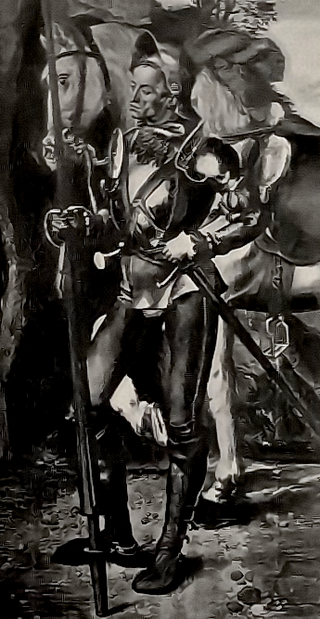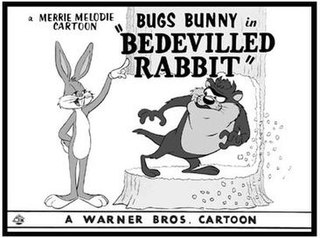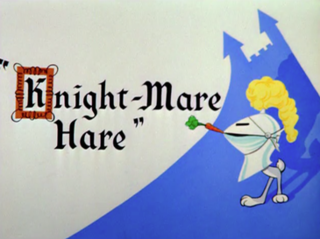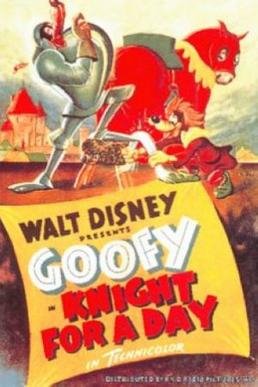Related Research Articles

Jousting is a medieval and renaissance martial game or hastilude between two combatants either on horse or on foot. The joust became an iconic characteristic of the knight in Romantic medievalism.

Knighty Knight Bugs is a 1958 Warner Bros. Looney Tunes cartoon directed by Friz Freleng, The short was released on August 23, 1958, and stars Bugs Bunny and Yosemite Sam.

Cecil Turtle is a fictional character in the Warner Bros. Looney Tunes and Merrie Melodies series of films. Though he made only three theatrical appearances, Cecil has the unusual distinction in that he is one of the very few characters who were able to outsmart Bugs Bunny, and the only one to do so three times in a row and at the rabbit's own game. Cecil often gives Bugs the taunting nickname of "Speedy" when addressing the rabbit.

King Arthur and the Knights of Justice is an animated series produced by Golden Films, C&D, and Bohbot Entertainment and created by Diane Eskenazi and Avi Arad, who also served as executive producers. The series aired from September 13, 1992, to December 12, 1993, with two seasons and twenty-six episodes. It aired as part of Bohbot's Amazin' Adventures programming block.

The Heckling Hare is a Merrie Melodies cartoon, released on July 5, 1941, and featuring Bugs Bunny and a dopey dog named Willoughby. The cartoon was directed by Tex Avery, written by Michael Maltese, animated by soon-to-be director Robert McKimson, and with musical direction by Carl W. Stalling. In a style that was becoming typical of the Bugs character, he easily outwitted and tormented his antagonist through the short, his only concern being what to do next to the dog.

A pauldron is a component of plate armor that evolved from spaulders in the 15th century. As with spaulders, pauldrons cover the shoulder area. Pauldrons tend to be larger than spaulders, covering the armpit, and sometimes parts of the back and chest. A pauldron typically consists of a single large dome-shaped piece to cover the shoulder with multiple lames attached to it to defend the arm and upper shoulder. On some suits of armour, especially those of Italian design, the pauldrons would usually be asymmetrical, with one pauldron covering less and sporting a cut-away to make room for a lance rest.

Ballot Box Bunny is a 1951 Warner Bros. Merrie Melodies theatrical cartoon short directed by Friz Freleng and written by Warren Foster. The cartoon was released on October 6, 1951, and features Bugs Bunny and Yosemite Sam.

Hair-Raising Hare is a Warner Bros. Merrie Melodies cartoon, released on May 25, 1946. It was directed by Chuck Jones and written by Tedd Pierce. It stars Bugs Bunny and features the first appearance of Chuck Jones' orange monster character "Gossamer".

Rabbit Hood is a 1949 Merrie Melodies cartoon released on December 24, 1949. The entry was directed by Chuck Jones and written by Michael Maltese, and features Bugs Bunny.

Dinadan is a Cornish knight of the Round Table in the Arthurian legend's chivalric romance tradition of the Prose Tristan and its adaptations, including a part of Le Morte d'Arthur. Best known for his humor and pragmatism, he is a close friend of the protagonist Tristan. Dinadan is the subject of several often comedic episodes until his murder by Mordred and Agravain.

Bunker Hill Bunny is a 1950 Warner Bros. Merrie Melodies theatrical cartoon short directed by Friz Freleng and written by Tedd Pierce. The short was released on September 23, 1950 and stars Bugs Bunny and Yosemite Sam as a Hessian mercenary in the American Revolution.

The Looney Looney Looney Bugs Bunny Movie is a 1981 American animated comedy package film with a compilation of classic Looney Tunes/Merrie Melodies Warner Bros. cartoon shorts and animated bridging sequences produced and directed by Friz Freleng, hosted by Bugs Bunny. The new footage was produced by Warner Bros. Animation. It was the first Looney Tunes/Merrie Melodies film with a compilation of classic cartoon comedy shorts produced by Warner Bros. Animation.

Bedevilled Rabbit is a 1957 Warner Bros. Merrie Melodies short directed by Robert McKimson. The short was released on April 13, 1957, and stars Bugs Bunny. In this cartoon, Bugs is lost in Tasmania, and has to deal with the Tasmanian Devil.
Captain Hareblower is a 1954 Warner Bros. Merrie Melodies theatrical cartoon short directed by Friz Freleng and written by Warren Foster. The short was released on January 16, 1954, and stars Bugs Bunny and Yosemite Sam.

Rabbit Every Monday is a 1951 Warner Bros. Looney Tunes cartoon directed by Friz Freleng. The short was released on February 10, 1951, and stars Bugs Bunny and Yosemite Sam. The title is a play on Chicken Every Sunday.
The Goofy Gophers is a 1947 Warner Bros. Looney Tunes cartoon directed by Bob Clampett and Arthur Davis. The short was released on January 25, 1947, and is the first appearance of the Goofy Gophers.

Knight-mare Hare is a 1955 Warner Bros. Merrie Melodies theatrical cartoon directed by Chuck Jones and written by Tedd Pierce. The short was released on October 1, 1955, and stars Bugs Bunny.
Daffy Duck and Porky Pig Meet the Groovie Goolies is a 1972 animated one-hour TV-movie that was aired on December 16 as an episode of the anthology series The ABC Saturday Superstar Movie. In this Filmation-produced movie, Daffy Duck, Porky Pig, and other Looney Tunes characters interact with the characters from the Filmation series Groovie Goolies.

A Knight for a Day is a 1946 Disney short film starring Goofy, which is loosely based on the novel A Connecticut Yankee in King Arthur's Court. Directed by Jack Hannah, this 7-minute animated comedy short was scripted by Bill Peet. While classified as a Goofy cartoon, Goofy himself is not used in this film, but his appearance is used as the basis for all the characters.
Bugs Bunny in King Arthur's Court is a 1978 animated television special directed by Chuck Jones. The special is based on Mark Twain's novel A Connecticut Yankee in King Arthur's Court, and features the Looney Tunes characters Bugs Bunny, Daffy Duck, Porky Pig, Elmer Fudd and Yosemite Sam. It marks the first use of Sam in a Jones-directed short or special, before From Hare to Eternity 19 years later in 1997.
References
- ↑ Lenburg, Jeff (1999). The Encyclopedia of Animated Cartoons. Checkmark Books. pp. 60–61. ISBN 0-8160-3831-7 . Retrieved 6 June 2020.
- ↑ Beck, Jerry; Friedwald, Will (1989). Looney Tunes and Merrie Melodies: A Complete Illustrated Guide to the Warner Bros. Cartoons. Henry Holt and Co. p. 200. ISBN 0-8050-0894-2.
- 1 2 3 4 5 6 7 8 9 Salda (1999), p. 206-208
- ↑ Salda (2013), unnumbered pages